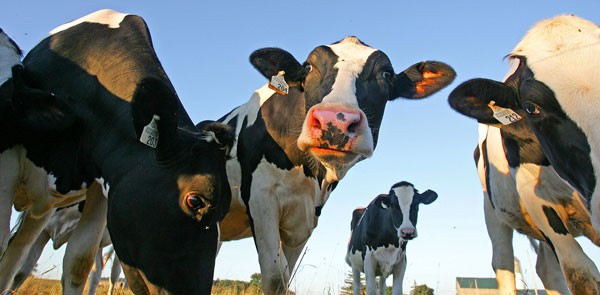
Raindrops slam against the windows of the little shop on Bay Street in Victoria. The glass is littered with white-lettered slogans boasting the lowest supplement prices in town.
Inside I wipe my feet on the face of the store’s muscle-bound mascot, Popeye, who winks up at me from the doormat. The walls are lined with rows of rainbow tubs, all sealed and packed with supplement powders. Browsing through the creatine, amino acid complexes, carbohydrates, and whey protein products means squeezing between towers of the stuff, which come in two, five, and ten-pound denominations.
Chris Kinnear could be Popeye himself, minus the pipe. He owns the Victoria franchise of Popeye’s Supplements. He sports an earring, jeans, and a store-uniform vest exposing his thick, prickly-haired arms.
Kinnear points to photos of trophy-laden athletes and decked out babes on the wall behind the counter and jerseys hanging from the ceiling, tokens from his most celebrated clients. “It’s scientifically impossible to be at your optimum health without supplementation,” Kinnear says. “Optimal health is not that easy; that’s why few people have it.”
Popeye’s biggest seller is whey protein, a milk product that has been on the market for about 25 years with production booming in the last five. According to Kinnear, whey supplements are a must for everyone, not just athletes and bodybuilders. His conviction is based on a school of thought that calls for a minimum protein intake that is double the standard dietary recommendation. The reason? Apparently, stuffing whey down your gullet after working out boosts muscle growth, and whey’s efficient absorption makes it mandatory for maintaining lean tissue and immune function. It is a near-literal interpretation of the old adage, “You are what you eat,” where highly refined protein equals hulk without bulk.
But is whey the miracle product its vendors make it out to be? Or is this just the latest battle in the dairy industry’s war for the hearts, minds and stomachs of North Americans in the age of nutraceuticals?
Milk, the miracle drink
Food historian Anne Mendelson has seen the rise and fall of many a popular diet.
“There seem to be backlashes and counter-backlashes all the time in popular nutrition,” she says. “There have always been protein fads and people jumping onto the protein bandwagon.” Indeed, the Atkins explosion of carbophobia followed a time when a healthy diet meant rationing protein, not gorging on it.
Mendelson’s latest book, Milk: The Surprising Story of Milk through the Ages, summarizes dairy’s shaky reputation: milk has been called everything from a “heart attack in a carton” to “nature’s perfect food,” depending on the prevailing attitudes of the day.
“Seems like people can’t just be content with foods that are pretty good, very useful and very nutritious,” says Mendelson. “People are on the lookout for miracle substances, for nutritional wonders.”
It isn’t just milk’s rating on the miracle scale, but also the very composition of milk that keeps changing. Dairy producers accommodate nutritional fads by adding or tossing components of milk to keep up with the prevailing fads. Whey protein, arguably the most transformed milk product in a long history of alteration, represents the reductio ad absurdum of this practice, whittling milk down to its nitrogenous constituents.
Once upon a time, “normal” milk was naturally soured by bacteria that are killed off by modern refrigeration. This made for a low lactose beverage more yogurt-like in flavour than the moustache-making drink of today.
But in the growing cities of the mid-19th century, milk peddlers convinced their customers that fresh, unfermented milk was better and healthier than soured milk (and worth more money). By 1840, fresh milk became an indispensable staple, “such that milk [was] not just one food among many but a fundamental necessity for human survival,” writes Mendelson.
Good milk was then judged by the thickness of its cream line – the fat that globs at the top of unhomogenized milk – until, hollering hell and heart disease, cholesterol-conscious consumers of the 1970s and ’80s drove whole milk to near extinction. “Nature’s Perfect Food” then slimmed to skim, with one or two per cent of the fat added back for more compromising consumers.
The defatting process also removes important nutrients, such that law requires skim milk to be fortified, at least with vitamin D. Milk’s list of add-ons is ever increasing; lactose, casein, vitamins, minerals, flavours, and even fish oil (for its laudable omega fatty acids) are commonly squeezed into lengthening ingredient labels.
Before pasteurization became standard, chalk or plaster was sometimes added to pass milk off as a purer product. Today, marketing and presentation still drive dairy trends, with science playing a secondary role. The “milk makes healthy bones” creed is a good example, as long-term studies actually don’t show any link between drinking milk and preventing osteoporosis.
Whey supplements represent the culmination of milk’s commodification, reducing its “wholesome goodness” into a protein-only powder. Except for its pairing with curds in a certain nursery rhyme, whey by itself was certainly not a word on the public tongue (or in the public’s breakfast shakes) until recently.
Miss Muffet was no bodybuilder
Up until about 25 years ago, whey was considered a waste product. Farmers dumped it into rivers or fed it to their pigs.
“People have been scratching their heads for generations, wondering what to do with this stuff,” says Mendelson. When stricter environmental standards disallowed the dumping of whey, the head-scratching grew more frantic. New processing techniques offered a solution. Whey protein isolate, the most popular supplement form, is dehydrated, filtered and concentrated into a fine powder that is upwards of 90 per cent protein by weight.
Gym dogma professes that anyone trying to beef up (or, technically speaking, “achieve muscle hypertrophy”) needs more protein than can be consumed in a single tuffet sitting. The alleged advantage for weightlifters is this: whey protein is quickly digested and, when eaten within an hour of training, directly feeds muscle tissue in a critical recovery time window.
There is a grain of truth to such claims. Controlled experiments do show improved muscle growth and function in participants who chug protein drinks after resistance training, compared to those who drink water or carbohydrate supplements. Such studies, however, report “minimal” differences and “minor advantages” – not miracles. A 2005 paper in the journal Metabolism concludes, “the present results may have relevance for individuals who are particularly interested in gaining muscle size.” Hardly an overwhelming vote for whey’s indispensability.
Still, the miracle claims persist. In 1985, Weider Health and Fitness Inc., producer of the protein and vitamin supplement “Anabolic Mega-Pak”, was fined for claiming, without any supporting evidence, that its products helped build muscle. While no one has stamped their products with such declarations recently, it has not stopped their sales reps from hyperbolizing the “minimal” and “minor advantages” described by science.
The case for whey as the sharpest tool in the protein shed is even less supported. Similar studies could not distinguish between the effects of whey and soy supplements. So how do gym goers get duped into buying whey, the pricier protein source?
Salespeople quote whey’s Biological Value (BV) score, often listing it as high as 104 even though the scale maximum is 100. Huh? The extra is the upper range of calculation error. BV represents nitrogen retention, but actually measures excreted nitrogen. What doesn’t end up in the toilet isn’t necessarily in the muscles, however. Some hypothesize that rapidly digested protein is oxidized in the liver instead. But never mind that – the three-digit BV sure looks good in magazine ads.
The World Health Organization and the U.S. Food and Drug Administration use the Protein Digestibility Corrected Amino Acid Score (PDCAAS) as a more accurate measure than the BV scale. Accounting for amino-acid-specific requirements and digestibility, the PDCAAS also gives whey the top grade: one out of one. However, whey shares the podium with casein, eggs and soy. For perspective, beef scores 0.92, beans score 0.68, and peanuts pull a mere 0.52.
“There are very few vegan athletes in the world,” says Kinnear, and according to him no one can win without whey supplements. “Which is patently false of course,” smiles Dave Shishkoff, president of the Victoria chapter of Organic Athlete, an organization for vegan athletes. “Anyone with a modicum of experience in competitive fields knows that training is what makes the biggest difference, although nutrition is important.”
No one denies that protein is part of a healthy diet and that a hard-working athlete needs at least a little more protein than Homer Simpson. But as Shiskoff says, “At the end of the day, amino acids are amino acids, whether they come from the teat of a cow or soy bean pods.”
So how much protein do we actually need?
h3.Enough is enough
The Canadian Dial-A-Dietician phone service recommends 0.8 grams of protein per kilogram of body weight per day for an active adult. While this number holds steady for organizations like Health Canada and the World Health Organization, groups with narrower agendas (like, say, selling protein) figure differently.
The American Whey Institute, founded by dairy company Davisco in 2001, is the first organization dedicated to promoting whey. They recommend the same amount of protein (0.8 grams) per pound, rather than per kilogram, of body weight. For a 150-pound person, that amounts to an extra two steaks’ worth of protein every day.
Chris Kinnear insists on a bare minimum one gram of protein per pound of lean tissue – which still doubles what he sees as outdated recommendations. The mantra in the gym is, “More is better,” and men especially will pack back a few hundred grams a day. But let’s try a different kind of number crunching. A pound of muscle contains roughly 100 grams of protein. Even a gain of one pound of muscle per week – an astronomical rate of growth – does not justify consuming daily multiples of hundreds of grams.
Fitness educator Tina Truscott starts the supplement section of her fitness theory course with a disclaimer: whey-faithful students can keep their own beliefs but still have to answer correctly on the exam. She writes in her course manual that “the growth of muscle mass is strictly controlled by genetic makeup and type of exercise performed – not the supplements you take.”
In fact, too much protein can actually do the body harm, writes Truscott. First off, excess calories from protein end up on our butts and bellies, not our biceps. Secondly, excess nitrogen is peed out, taking water with it and risking dehydration. Doubling incoming protein quadruples the urine going out. Thirdly, processing excess nitrogen takes a heavy toll on the kidneys and digestive system and, in worst cases, may result in kidney stones, vitamin B6 deficiency, and bone density loss.
But few people actually overdose on protein. Health Canada measures over- and underconsumption against what’s called the “Acceptable Macronutrient Distribution Range” for protein. It is more common for Canadians to get dangerously little protein than a dangerous excess, though less than four per cent lie outside the AMDR at either end.
According to Bonnie Roill, a personal trainer, dietitian and advocate for whey, calorie-restricting dieters and elderly people are most prone to protein deficiency, losing crucial lean tissue with weight loss or with aging.
“As we age, a lot of people don’t desire protein foods as much as they did when they were younger,” says Roill. “I see a lot of older people whose morning meal is tea and toast and lunchtime might be soup and crackers.” The result is an accelerated sarcopenia – itself a natural process of weakening with age.
As for dieters, she says: “I see too many women who lose 50 pounds and they are sauced. They’ve lost all their muscle and they look sickly – they don’t look healthy.”
Of course, eggs, beef or beans would do the trick. But whey works as a quick mix-and-go type product for those too busy (or too lazy) to cook, or as a vanilla, chocolate, or strawberry-flavoured alternative for picky eaters. A hidden convenience is the perceived separation from the ethical issues that surround more earthly dairy products, but this, too, has little basis in fact.
The American whey
Without the cartoon cows that decorate milk cartons adorning tubs of whey powder, it’s easy to forget that whey protein gets pumped out a cow’s teats, and is in no way exempt from the unpleasantness of large scale industrial farming.
The U.S. is the world’s leading whey manufacturer. American dairy exports represent a three-billion-dollar industry. Last year, 58 per cent of U.S. dairy exports by weight consisted of whey. Half of American whey stays at home.
The American dairy industry knows it has a good thing going. The U.S. Dairy Export Council trumpets whey’s health benefits, while state-level dairy councils sing its praises. The result is store shelves brimming with whey products in dozens of flavours, in everything from Tetra Paks to 25-pound barrels.
Not in Canada. Canadian milk that is sold to manufacturers for further processing is classified according to product categories. Supplements weren’t included as a category until last year. Even so, no whey manufacturing happens in Canada. The domestic market is not large enough to justify the expensive processing plants.
Yet the dairy industry holds powerful sway over what ends up in our fridges. The B.C. Dairy Foundation, for instance, helped write our Canada Food Guide, which recommends two to four servings of “milk or alternatives” every day. A strange and arbitrary food group, “milk and alternatives” ought to be renamed “highly altered lactic concoctions.” The only non-dairy “alternative” on the list is fortified soy milk. The U.S. also has dairy interests embedded in its nutritional advisory boards: its 2005 Dietary Guidelines for Americans was published in partnership with the U.S. Department of Agriculture – hardly a neutral organization.
Even though the message doesn’t come from Canadian dairy boards, Canadians still get duped into thinking they need whey supplements in order to be strong and healthy. Though we don’t get as many advertisements as our whey-guzzling neighbours, the boom in whey sales shows that Canuck distributors have been doing their homework and that the words of American marketers filter through. Proof is at the nearest Starbucks, where coffee-craving dieters order whey protein in their skinny vanilla lattes, and whey protein shakes are called Vivanno Smoothies.
But don’t let the trendy enthusiasm fool you. Whey-guzzlers are not participating in some nutritional revolution. The extent to which zealous American dairy boards promote whey while Canadian boards do not shows that money and politics have more influence in dietary advice than we’d like to think. The health conscious among us would be far better served by taking the time to cook and eat well instead of compensating with made up miracle foods.
Popeye’s secret weapon
Several customers brave the rain with plastic tubs of Popeye’s supplements tucked under each arm.
“It’s kind of sad that people have so much faith in a useful food being disassembled into its arbitrary components like whey,” Anne Mendelson had said to me. I also think back to Truscott’s fitness manual, where she wrote: “People wanting a “˜quick fix’ turn to protein supplements.” The original Popeye really did promote the miracle drink idea – though spinach seems somewhat more holistic than whey.
I didn’t buy any supplements – not even for the photos of tanned muscular bodies that adorned them, cropped to show inflated pectorals and abdominals hard as tire treads. I left the massive pillars of products thinking of the tanker loads of milk needed to make a batch of protein supplement – and how the cozy carpeted store makes the image of confined and stinky rows of cattle seem like a bad dream.
Can it really be healthier to eat food extracts instead of food?
Opening my umbrella against the storm, I answer my own question: No whey.





_780_520_90_s_c1.jpg)
